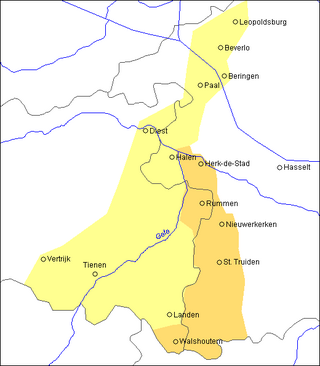Related Research Articles

Low Saxon, also known as West Low German are a group of Low German dialects spoken in parts of the Netherlands, northwestern Germany and southern Denmark. It is one of two dialect groups, the other being East Low German.
A diphthong, also known as a gliding vowel or a vowel glide, is a combination of two adjacent vowel sounds within the same syllable. Technically, a diphthong is a vowel with two different targets: that is, the tongue moves during the pronunciation of the vowel. In most varieties of English, the phrase "no highway cowboy" has five distinct diphthongs, one in every syllable.
Middle Dutch is a collective name for a number of closely related West Germanic dialects whose ancestor was Old Dutch. It was spoken and written between 1150 and 1500. Until the advent of Modern Dutch after 1500 or c. 1550, there was no overarching standard language, but all dialects were mutually intelligible. During that period, a rich Medieval Dutch literature developed, which had not yet existed during Old Dutch. The various literary works of the time are often very readable for speakers of Modern Dutch since Dutch is a rather conservative language.
The phonology of Portuguese varies among dialects, in extreme cases leading to some difficulties in mutual intelligibility. This article on phonology focuses on the pronunciations that are generally regarded as standard. Since Portuguese is a pluricentric language, and differences between European Portuguese (EP), Brazilian Portuguese (BP), and Angolan Portuguese (AP) can be considerable, varieties are distinguished whenever necessary.

East Flemish is a collective term for the two easternmost subdivisions of the so-called Flemish dialects, native to the southwest of the Dutch language area, which also include West Flemish. Their position between West Flemish and Brabantian has caused East Flemish dialects to be grouped with the latter as well. They are spoken mainly in the province of East Flanders and a narrow strip in the southeast of West Flanders in Belgium and eastern Zeelandic Flanders in the Netherlands. Even though the dialects of the Dender area are often discussed together with the East Flemish dialects because of their location, the latter are actually South Brabantian.

Dutch Low Saxon are Low Saxon dialects from the Low German language that are spoken in the northeastern Netherlands and are mostly, but not exclusively, written with local, unstandardised orthographies based on Standard Dutch orthography.
Tweants is a group of non-standardised Dutch Low Saxon dialects, descending from Old Saxon.
Dutch phonology is similar to that of other West Germanic languages, especially Afrikaans and West Frisian.
Unlike many languages, Icelandic has only very minor dialectal differences in sounds. The language has both monophthongs and diphthongs, and many consonants can be voiced or unvoiced.
Afrikaans has a similar phonology to other West Germanic languages, especially Dutch.
The phonology of Old Saxon mirrors that of the other ancient Germanic languages, and also, to a lesser extent, that of modern West Germanic languages such as English, Dutch, Frisian, German, and Low German.
This article is about the phonology and phonetics of the West Frisian language.
This article covers the phonology of the Orsmaal-Gussenhoven dialect, a variety of Getelands spoken in Orsmaal-Gussenhoven, a village in the Linter municipality.
Hamont-Achel dialect or Hamont-Achel Limburgish is the city dialect and variant of Limburgish spoken in the Belgian city of Hamont-Achel alongside the Dutch language.
Chemnitz dialect is a distinct German dialect of the city of Chemnitz and an urban variety of Vorerzgebirgisch, a variant of Upper Saxon German.
The Hague dialect is a dialect of Dutch mostly spoken in The Hague. It differs from Standard Dutch almost exclusively in pronunciation.
Hasselt dialect or Hasselt Limburgish is the city dialect and variant of Limburgish spoken in the Belgian city of Hasselt alongside the Dutch language. All of its speakers are bilingual with standard Dutch.
Weert dialect or Weert Limburgish is the city dialect and variant of Limburgish spoken in the Dutch city of Weert alongside Standard Dutch. All of its speakers are bilingual with standard Dutch. There are two varieties of the dialect: rural and urban. The latter is called Stadsweerts in Standard Dutch and Stadswieërts in the city dialect. Van der Looij gives the Dutch name buitenijen for the peripheral dialect.

Getelands or West Getelands is a South Brabantian dialect spoken in the eastern part of Flemish Brabant as well as the western part of Limburg in Belgium. It is a transitional dialect between South Brabantian and West Limburgish.
The phonology of the Maastrichtian dialect, especially with regards to vowels is quite extensive due to the dialect's tonal nature.
References
- ↑ Sallaans at Ethnologue (25th ed., 2022)

- ↑ A. A. Weijnen, Nederlandse dialectkunde, 1958, p. 461, Kaart 36a - De noordoostelijke dialecten (online)
- ↑ Henk Bloemhoff, Jurjen van der Kooi, Hermann Niebaum en Siemon Reker (red.), Handboek Nedersaksische Taal- en Letterkunde, Assen: Van Gorcum
- ↑ H. Scholtmeijer (2006), Mörn! Taalgids Overijssel, Assen: In Boekvorm Uitgevers bv. (p.64-65)
- ↑ G.G. Kloeke (1927) De Hollandsche expansie in de zestiende en zeventiende eeuw en haar weerspiegeling in de hedendaagsche Nederlandsche dialecten: Proeve eener historisch-dialectgeographische synthese
- ↑ Spa (2011), pp. 40, 47.
- ↑ Spa (2011), p. 47.
- ↑ Spa (2011), pp. 42–43.
- ↑ Spa (2011), pp. 11–35.
- ↑ Spa (2011), pp. 19, 21, 23, 42.
- ↑ Spa (2011).
- ↑ Spa (2011), pp. 35–39.
- ↑ Spa (2011), p. 44.